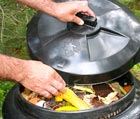- Gardening Tips |
- | What's NEW! |
- | Contact Us |
- | Sitemap
Asbestos and Vermiculite Soil Conditioners
Could Pose Asbestos Hazard
Author: James O'Shea
Is asbestos and vermiculite a concern for gardeners?
Although asbestos containing products have been banned and are now better regulated, among new products that may still contain asbestos are soil retention enhancers such as vermiculite.
In this article, James provides more information about what to look for regarding asbestos and vermiculite.
When we hear the word "asbestos" we often think back on the controversy of the late 1970's when it became common knowledge that asbestos was indeed a human health hazard.
While most asbestos containing products were banned by the Consumer Product Safety Commission and regulated by the Environmental Protection Agency, unfortunately it may still exist in hundreds of older products as well as in trace amounts of newly manufactured products.
Among new products that may still contain asbestos are soil retention enhancers, particularly vermiculite.
Vermiculite is mined from natural deposits across the globe and has a myriad of uses including commercial and private gardening. Vermiculite forms over millions of years due to the weathering of the mineral, biotite.
Unfortunately, former biotite deposits are often in close proximity to deposits of diopside, which upon being subjected to the same weathering and age conditions becomes asbestos.
In Libby, MT one particular mine shipped hundreds of thousands of tons of asbestos-contaminated vermiculite across the country.
Hundreds of the Libby mine's employees and residents of the town were diagnosed with mesothelioma, a rare and aggressive cancer that is known only to be caused by asbestos exposure. The Libby mine was not the only manufacturers of vermiculite to ship asbestos with their products.
Many other manufacturers were doing the same thing before EPA testing and regulations finally forced them to limit the amount of residual asbestos dust in the vermiculite.
Today, most vermiculite is safe. However, that is not to say it cannot contain asbestos.
Vermiculite which is accompanied by a great deal of dust likely has residual asbestos in its contents and should be used with caution.
Current EPA regulations ban products which contain 1% or more asbestos. Unfortunately even products containing less that 1% asbestos are still extremely hazardous, particularly when in loose dust form as vermiculite often is manufactured.
Mesothelioma incidence has been known to be high in commercial gardeners and other occupations which deal with large amounts of loose vermiculite.
Fortunately, exposure to asbestos-contaminated vermiculite can be avoided if consumers follow simple precautions.
Note the appearance of the vermiculite. If it seems to carry a great deal of residual dust, dispose of it outdoors. Most manufacturers of vermiculite mark their products packaging with "Non Dusty" labels. These refined granules are often slightly more expensive but they are certainly the safest.
============ RESOURCE ============
References:
Environmental Protection Agency. EPA Asbestos Materials Ban. 1989
Consumer Product Safety Commission. Asbestos Consumer Products.
Related Content:
To Top of this Asbestos and Vermiculite page
Return to Gardening Tips Home Page
Gardening Updates
Note: We'd love you to send us your favorite garden pics to feature on our new pages!
Contact Us and we'll send you an email address that can accommodate your photographs.

